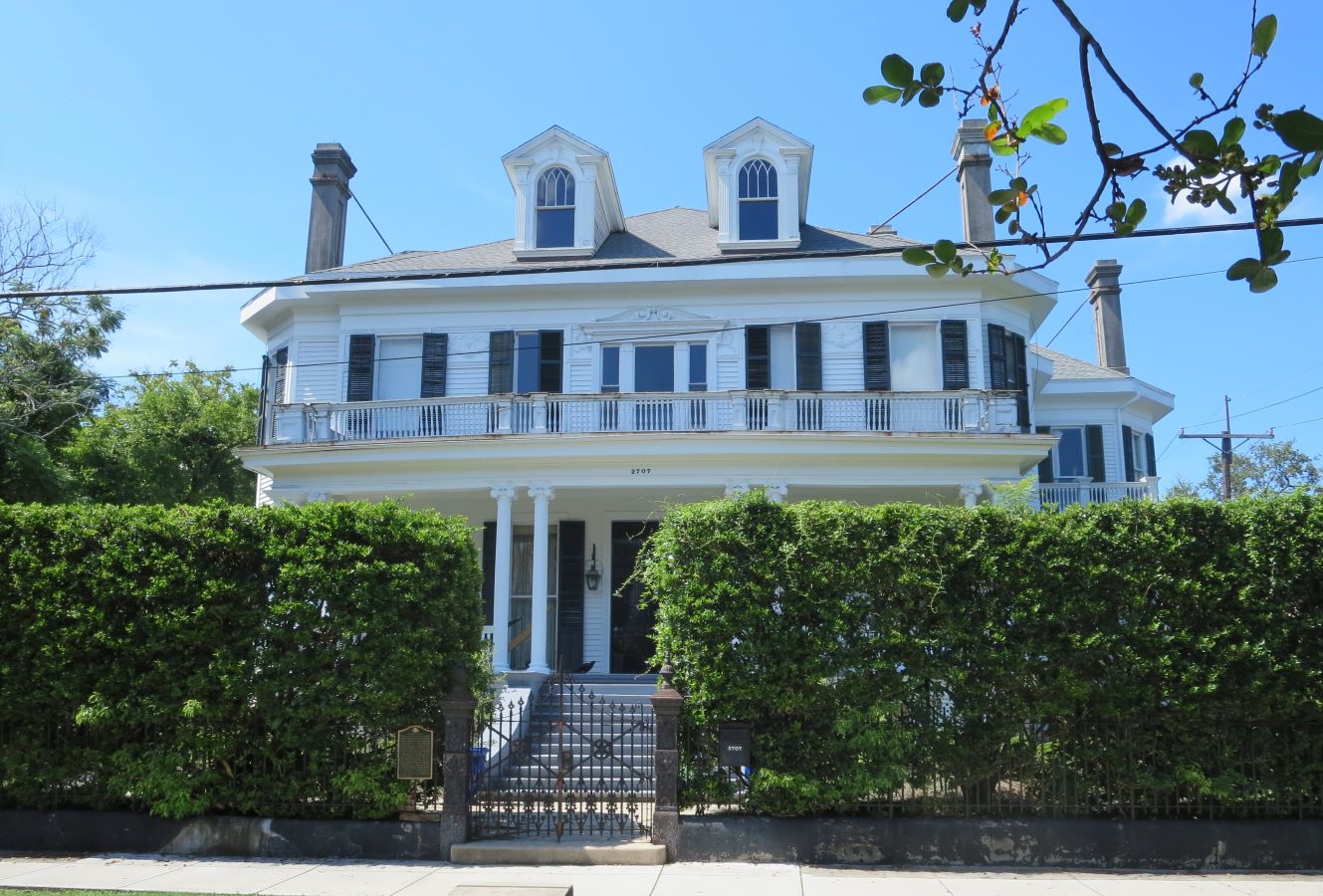Louisiana Film Industry
An early participant in the industrialization of film exhibition, distribution, and production, Louisiana adopted the moniker “Hollywood South” in the early twenty-first century.

Louisiana Endowment for the Humanities
2707 Coliseum Street in New Orleans was a major filming location for the 2008 Academy Award–winning film, The Curious Case of Benjamin Button. Photo by Erin Greenwald.
An early participant in the industrialization of film exhibition, distribution, and production, the Louisiana film industry continues to compete with other regions to produce major motion pictures. The evolution of this location-based production owes itself to a series of push-and-pull forces in the state and the global film economy.
Industry Beginnings
Film as a technology became an industry through a series of economic practices that enabled the mass creation, exchange, and sale of media to a viewing public. In the early twentieth century, New Orleans was an epicenter for a burgeoning exhibition and distribution economy based on film exchanges that rented film reels, mainly produced in the Northeast, to be shown through a circuit of southern venues aimed at a new consumer class for mass entertainment. Located in New Orleans, Vitascope Hall became the first storefront movie arcade in the United States in 1896. Within a decade the Dixie Film Company became the first major film exchange in the South and was a driving wedge between rival theaters. Dixie disappeared into the Motion Picture Patents Company distribution monopoly through a series of mergers, and one major theater chain, Saenger Amusement Company, dominated the New Orleans exhibition market over competing theaters and movie palaces.
Attempts to seed film production companies were less successful. Early film producer and entrepreneur William “Coronel” Selig abandoned the first attempt in New Orleans before launching a studio in Los Angeles, the first permanent one in a cluster of studios to be called “Hollywood” by 1920. The “Golden Age of Hollywood” was defined by the vertical integration of the Hollywood film studios over distribution and exhibition through exclusivity agreements with theater chains, such as Saenger, which at its apex operated 340 cinemas across the South and Puerto Rico.
“Hollywood South”
The Louisiana film industry was legislated into national prominence in 2002, when a coalition of lawmakers and lobbyists passed the Louisiana Motion Picture Incentive Act. Before the legislation local film commissions and a 1990 state statute provided rebates for Hollywood productions that aimed to promote the state and attract tourism. The new policy leveraged state tax credits to guarantee an upfront percentage of production budgets and payroll expenditures for local labor. Aimed at attracting film shoots for all big-budget projects regardless of the content they produced, the program mirrored the success of similar policies enacted in British Columbia, Canada. Whereas the former was dubbed “Hollywood North,” Louisiana adopted the moniker “Hollywood South.”
The Governor’s Office of Film and Video Development administered the transferrable tax exemption certificates, and it became a hub for assisting producers, who formed limited liability companies that could trade or cash in their credits and sought resources for in-state hiring and location scouting. Later iterations of the law expanded industry benefits from 30 percent of qualified production expenses to 45 percent in 2009, with additional credits for locally created screenplays and musical scores. In 2013 the official film office of Los Angeles named Louisiana the “world’s busiest production hub,” a title later ceded, falling behind California, New York, and Georgia, when the state capped its fiscal liabilities in 2015.
New Orleans has remained the heart of film-industry activity in the state. By the 2010s Film New Orleans became a branch of the Mayor’s Office of Cultural Economy to streamline production permitting for using public rights of way and spaces. New film studios opened in the city, alongside other facilities in Baton Rouge and Shreveport, to capture highly mobile productions and their professional crew bases, many of which would rotate and relocate to regions with strong film labor markets. Oscar-winning films that took advantage of tax credits include 12 Years a Slave (dir. Steve McQueen, 2013) and Green Book (dir. Peter Farrelly, 2018). Alongside Hollywood blockbusters, documentary and other forms of independent production grew through the aggregation of film workers in the area networked through film societies, festivals, and other creative industries, such as music, theater, fashion, and design. Noteworthy independent productions include When the Levees Broke: A Requiem in Four Acts (dir. Spike Lee, 2006) and Beasts of the Southern Wild (dir. Benh Zeitlin, 2012). Founded by AmeriCorps VISTA volunteers in 1972, the New Orleans Video Access Center remains the longest, continuously running media arts nonprofit in the South.
Despite critical acclamations and employment impacts, Louisiana’s film industry remains economically precarious and politically controversial. The scale of incentives has ebbed and flowed in response to other spending woes in the state, creating ripple effects that can impact filming schedules years later. The film industry depends on state coffers to fund a level of incentives that matches or exceeds those offered by other US states and some countries. Regions in the state also bear the responsibility of attracting industry professionals and talent to establish permanent roots in an industry known for its mobile and flexible labor force. State and regional officials have mitigated threats to the industry by expanding incentives for infrastructure construction and creative industries related to film. None of these instruments, however, are impervious to global film industry trends. The COVID-19 pandemic, followed by union and guild work stoppages between 2020 and 2024, have left the Louisiana film industry vulnerable to rollbacks to an earlier age of location-based production.
